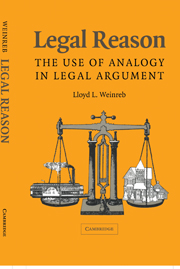Book contents
- Frontmatter
- Contents
- Preface
- Introduction
- 1 Analogy and Inductive and Deductive Reasoning
- 2 Steamboats, Broadcast Transmissions, and Electronic Eavesdropping
- 3 Analogical Legal Reasoning
- 4 Analogical Reasoning, Legal Education, and the Law
- Appendix A Note on Analogical Reasoning
- Appendix B Biographical Notes
- Notes
- Index
1 - Analogy and Inductive and Deductive Reasoning
Published online by Cambridge University Press: 05 June 2012
- Frontmatter
- Contents
- Preface
- Introduction
- 1 Analogy and Inductive and Deductive Reasoning
- 2 Steamboats, Broadcast Transmissions, and Electronic Eavesdropping
- 3 Analogical Legal Reasoning
- 4 Analogical Reasoning, Legal Education, and the Law
- Appendix A Note on Analogical Reasoning
- Appendix B Biographical Notes
- Notes
- Index
Summary
Scott Brewer's account of analogical legal arguments includes them within a broad family of legal and nonlegal arguments, characterized by “the use of examples in the process of moving from premises to conclusion.” Among the other kinds of legal argument within this family, he mentions reasoning from precedents, application of “equal protection” norms, and the “ejusdem generis” canon for the construction of documents. An analogical argument, he says, consists of more than the analogy itself. It is a patterned series of steps, the “rational force” of which depends on “the relation between the truth of the argument's premises and that of its conclusion.” His principal concern is to show that the employment of an analogy in the manner he describes gives the resulting argument a good deal more rational force than is generally supposed.
The pattern of analogical argument, Brewer says, includes three steps:
1. Abduction in a context of doubt. The reasoner is uncertain about the extension of some term – what it refers to – that has legal consequences in the case under consideration. More concretely, he is uncertain about how legally to classify some phenomenon – person, thing, event, or circumstance – with respect to the matter in question. So, for example, he may be uncertain whether it is a search to which the Fourth Amendment applies if a trained dog sniffs closed luggage left in a public place and signals to the police that it contains drugs.
- Type
- Chapter
- Information
- Legal ReasonThe Use of Analogy in Legal Argument, pp. 19 - 40Publisher: Cambridge University PressPrint publication year: 2005



